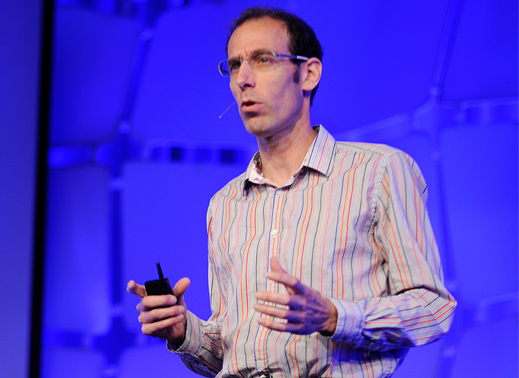The pros and cons of trying to adjust the global thermostat
David Keith, a professor of applied
physics at Harvard, speaks about geoengineering at the Techonomy 2012 conference
in Tucscon on Monday. (Techonomy.com / November
12, 2012
|
According to David Keith, a physicist
at Harvard, it's a fairly straightforward proposition to reduce the rate of
warming on earth, and not all that expensive in the grand scheme of things. One
possibility: fly a couple of customized corporate jets into the stratosphere
every day and dump a lot of sulfur, creating thin clouds that reflect away some
of the sunlight.
"The hard questions here really aren't technical," Keith said Monday.
"They're fundamentally political."
And the political questions about this sort of
environmental manipulation, known in science circles as "geoengineering," are
doozies. Keith and Andrew Parker, who helped write the London-based Royal
Society's report
on geoengineering, ran through a series of them during a panel discussion at
the Techonomy
2012 conference in Tucson: Who gets to say yes or no to geoengineering? If
engineers can manipulate the global thermostat, who decides what's the right
temperature? Who will judge whether a geoengineering project is responsible for
any subsequent weather-related catastrophe, and who'll be held liable?
There are no answers to those questions yet. A
number of non-governmental organizations and environmental groups have been
developing guidelines for the governance
issues surrounding geoengineering, but it's not clear that this effort will lead
to a binding legal framework.
The sun-reflecting technique has been talked about by scientists since the
1960s, Keith said, although there's still some disagreement about how effective
it would be. One reason advocates believe it would work, he said, is that nature
has effectively conducted a series of pilot projects over the years, in the form
of major volcanic eruptions that have thrown tons of sulfur into the upper
atmosphere and temporarily changed the climate.In the theoretical scenario Keith outlined, two or three jets would disperse about 20,000 tons of sulfur into the stratosphere every year, starting in 2020, with a goal of slashing the rate of warming in half. That's a minuscule amount of sulfur compared to the amount that's emitted into the lower atmosphere as pollution, Keith said. Because carbon emissions would also continue, however, the amount of sulfur injected into the stratosphere would have to grow over time, possibly reaching 100,000 tons in 2030. Even then, though, the cost -- maybe $100 million -- would be a fraction of the amount spent on clean energy technology, which Keith said was about $270 billion last year.
"It's frighteningly doable. All of the hardware is there ... and a lot of the science is there too," Keith said. And if the goal is reducing the risks of global warming in the near term, he argued, "this is essentially the only thing you can do."
Just because it's doable, however, doesn't mean it's a solution or even a good idea.
The biggest fear about geoengineering, Keith said, is the idea alone "takes away the incentive to get serious about carbon emissions." Ultimately, he argued, the world's is going to have to wean itself completely from carbon-emitting power plants. The longer it takes countries to do so, the further the world moves from the climate we have today.
Yet aside from a United
Nations convention on biological
diversity, no international law or treaty forbids anyone from doing
geoengineering for the sake of averting climate change, Parker said. As a
result, countries that suffer acutely from the effects of global warming may
thus be tempted to try to adjust the global thermostat unilaterally. They may
also find cheerleaders in the coal industry, which may see geoengineering as a
way to forestall efforts to phase out coal-burning power plants, said the
panel's moderator, Jeff Goodell of Rolling Stone magazine.
At this point, at least, there's no way to confine
the effects of geoengineering to a single country, Keith said. So if China started peppering the
stratosphere with sulfur and India was hit by a cataclysmic cyclone, Parker
asked, what could India do in response? Bomb China's runways?
The liability issues may stop private companies from taking the initiative on
geoengineering projects. Keith said you wouldn't want companies deciding when
and where to do geoengineering, but they have a role to play in figuring out how
to do it. He added, "If we want to de-carbonize the world, we have to energize
private innovation."There are important ethical questions too, and any effort to physically alter the climate is sure to draw complaints from those who believe such things are God's province alone. But Andrew argued that there's another ethical and moral issue at work, which is the potential suffering that global warming may bring to vulnerable populations around the world in the decades it may take to mitigate it.
Click on the image below to watch a video of Keith and Parker's session at Techonomy. http://www.latimes.com/news/opinion/opinion-la/la-ol-geoengineering-political-consequences-20121112,0,1660936.story










